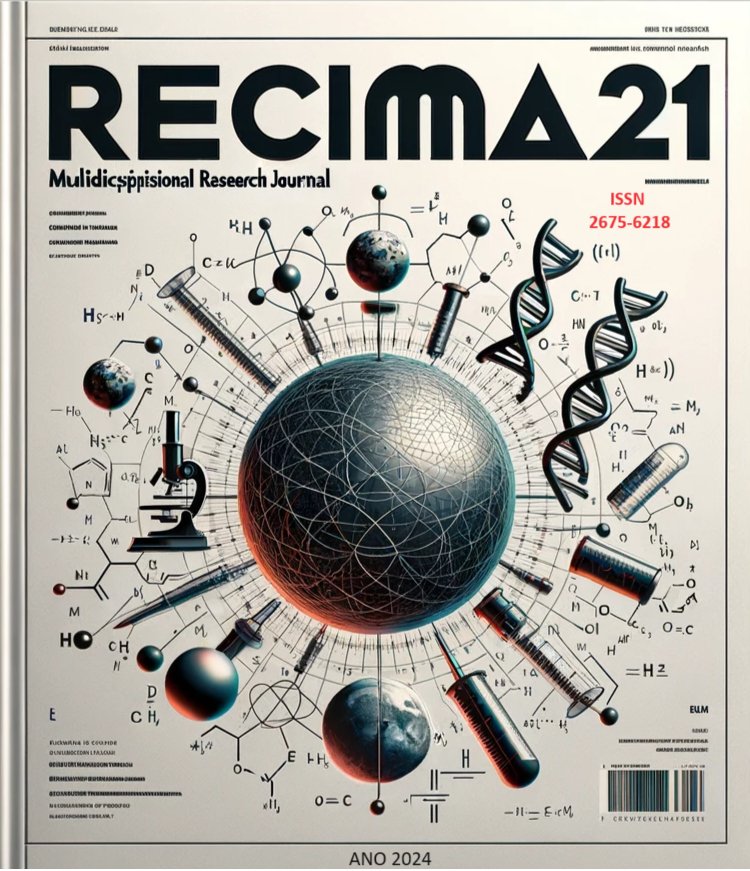AVALIAÇÃO DO TEOR DA FIBRA DA LARANJA NACIONAL E IMPORTADA COMERCIALIZADA NO MERCADO DE WARESTA EM NAMPULA, MOÇAMBIQUE
DOI:
https://doi.org/10.47820/recima21.v5i4.5108Palavras-chave:
Fibra dietética. Laranja. FrutaResumo
A laranja é uma fruta do género Citrus, supostamente originária da Ásia e com muita abundância em sazonalidades nos países da costa oriental da africa. Ela é considerada uma boa fonte de fibra dietética. A predominância da desnutrição a diferentes níveis na província de Nampula, foi preponderante para a avaliação da quantidade de fibra existente na laranja nacional e nas laranjas importadas, para aconselhar o consumidor a consumirem laranja com maior conteúdo de fibra como forma de aproveitar os nutrientes disponibilizados, desta feita, objetivou ̵ se através deste estudo, avaliar o teor de fibra das laranjas comercializadas no mercado de Waresta em Nampula. A natureza deste estudo é analítica observacional e com uma abordagem quantitativa, a população do estudo foi de 100 laranjas dividas em 14 amostras, e as análises laboratoriais foram feitas em triplicas e a posterior os dados foram analisados com o programa SPSS versão 25. De acordo os resultados da análise, as laranjas nacionais apresentam uma quantidade elevada de fibra comparada com a importada, como ilustram as medias dos resultados das duas variáveis, laranjas nacional igual a 0,864 e as importadas 0,546 de fibra. A análise bi-caudal encontrou uma diferença significativa por meio do teste-t de Student, com intervalo de confiança de 95% e erro de 5%, onde o valor de t foi igual a -3,916.
Downloads
Referências
Paulista UE, Filho M. Desenvolvimento histórico da citricultura Desenvolvimento histórico da citricultura. 2010.
Gon M, Coordena MR, Filho VM. Manual de citros. 2018. 56p p.
Hassan G, Umar J, Ikeh O, Aliero A, Pura DQ, Danfodiyo UU. Composição Nutricional e Antinutricional do Fruto Strychnos innocua Del. (Laranjeira de Macaco) Celulose cultivada Xem Zuru, Nigéria 1L.G. 2014;22(1990):33 DOI: https://doi.org/10.4314/njbas.v22i1.6
Macedo Owado. Avaliação da cadeia produtiva da laranja [citrus sinensis (l.) osbeck] nos municípios de iranduba, Manacapuru, Manaus e rio preto da eva no estado do amazonas. osmar. 2019;9–25
Santos Jr. produtos hortofrutícolas joana rosa santos dissertação para obtenção do grau de mestre em engenharia alimentar. 2013
Murga-garrido SM, Hong Q, Cross TL, Hutchison ER, Han J, Thomas SP, et al. Gut microbiome variation modulates the effects of dietary fiber on host metabolism. 2021;1–26. DOI: https://doi.org/10.1186/s40168-021-01061-6
Meira CF, Capitani CD, Filho AB, Berti M, Barros A. Contribuição dos diferentes alimentos segundo a classificação Nova para a ingestão de fibras alimentares em adolescentes Contribution of different foods according to the Nova classification to dietary fiber intake in adolescents. 2020;3147–60. DOI: https://doi.org/10.1590/1413-81232021268.09592020
Silva LAS da, Oliveira VC de. Principais aplicações dos resíduos da laranja e sua importância industrial. 2020; 22:1–11.
Weickert and Pfeiffer Impact of Dietary Fiber Consumption on Insulin Resistance and the Prevention of Type 2 Diabete, first published online January 25, 2018 DOI: https://doi.org/10.1093/jn/nxx008
Ruiz-Margáin A, Macías-Rodríguez RU, Ríos-Torres SL, Román-Calleja BM, Méndez-Guerrero O, Rodríguez Córdova P, et al. Efecto de una dieta rica en proteínas y alta en fibra más la suplementación con aminoácidos de cadena ramificada sobre el estado nutricional de pacientes con cirrosis. Revista de Gastroenterología de México. 2018;83:9-15 DOI: https://doi.org/10.1016/j.rgmx.2017.02.005
Betrapally NS, Gillevet PM, Bajaj JS. Gut microbiome and liver disease. Transl Res. 2017;179:49-59. DOI: https://doi.org/10.1016/j.trsl.2016.07.005
Barry V. McClear, Measurement of Dietary Fiber: Which AOAC Official Method of Analysis SM to Use Journal of AOAC International, 2023;106(4) DOI: https://doi.org/10.1093/jaoacint/qsad051
Prosky, L., Asp, N.G., Furda, I., DeVries, J.W., Schweizer, T.F., & Harland, B.F. Fonio grains: Physicochemical properties, nutritional potential, and food applications. J. AOAC Int. 1985;68: 677-679. DOI: https://doi.org/10.1093/jaoac/68.4.677
Berti M, Barros DA, I LPC. Elevada prevalência de inadequação do consumo de fibras alimentares em idosos e fatores associados : um estudo de base populacional. 2019;1-13.
Manual do equipamento de quantifição de fibra dose fiber
Grigelmo-miguel N, Martõân-belloso O. Caracterização da fibra alimentar proveniente da extração do suco de laranja. 2018;9969(98).
Mineiro SAL. Fibra Alimentar: composição, métodos e implicações alimentares. Lisboa; 2014.
Ramirez AJE, Hubscher HG. Análise da fibra da Laranja vs laranja importada: em defesa de seu uso como alimento funcional. Minas Gerais. Associação Bras Aliment e Nutr. 2016;36(3):79-91.
Tomás JCC. Variedades e porta-enxertos de citrinos. Alargave; 2016
Mineiro SAL. Fibra Alimentar: composição, métodos e implicações alimentares. Lisboa; 2014.
Downloads
Publicado
Licença
Copyright (c) 2024 RECIMA21 - Revista Científica Multidisciplinar - ISSN 2675-6218

Este trabalho está licenciado sob uma licença Creative Commons Attribution 4.0 International License.
Os direitos autorais dos artigos/resenhas/TCCs publicados pertecem à revista RECIMA21, e seguem o padrão Creative Commons (CC BY 4.0), permitindo a cópia ou reprodução, desde que cite a fonte e respeite os direitos dos autores e contenham menção aos mesmos nos créditos. Toda e qualquer obra publicada na revista, seu conteúdo é de responsabilidade dos autores, cabendo a RECIMA21 apenas ser o veículo de divulgação, seguindo os padrões nacionais e internacionais de publicação.













